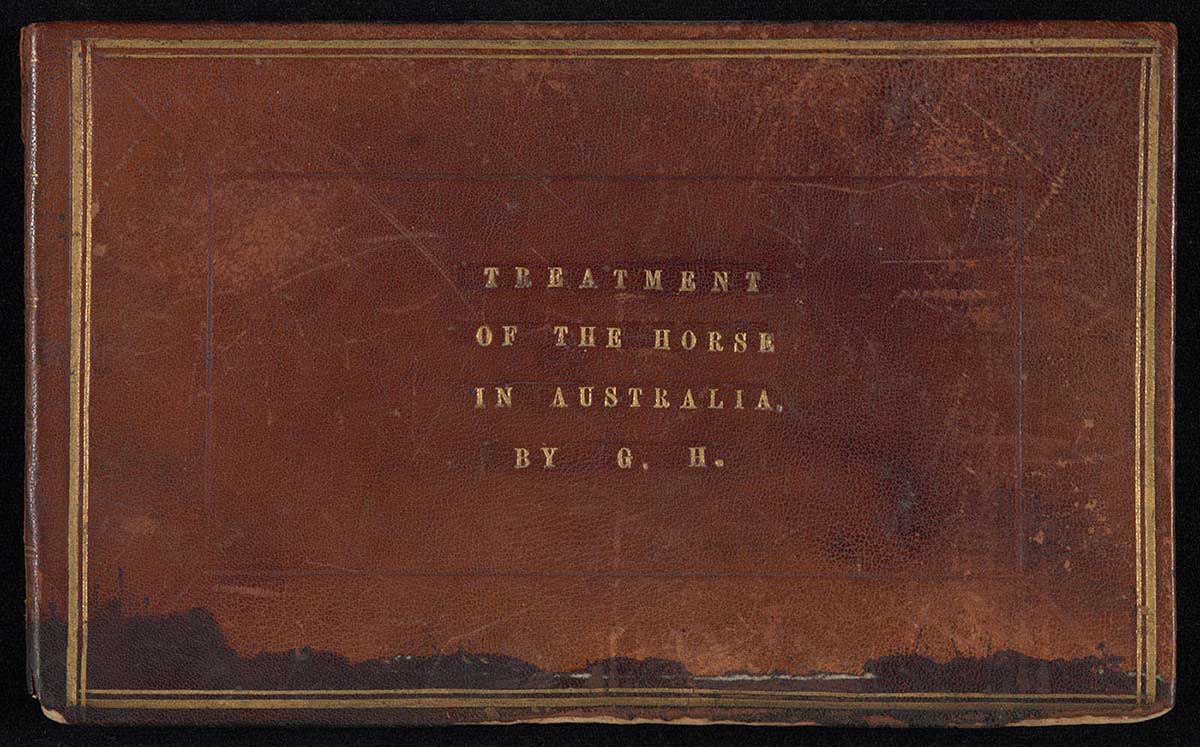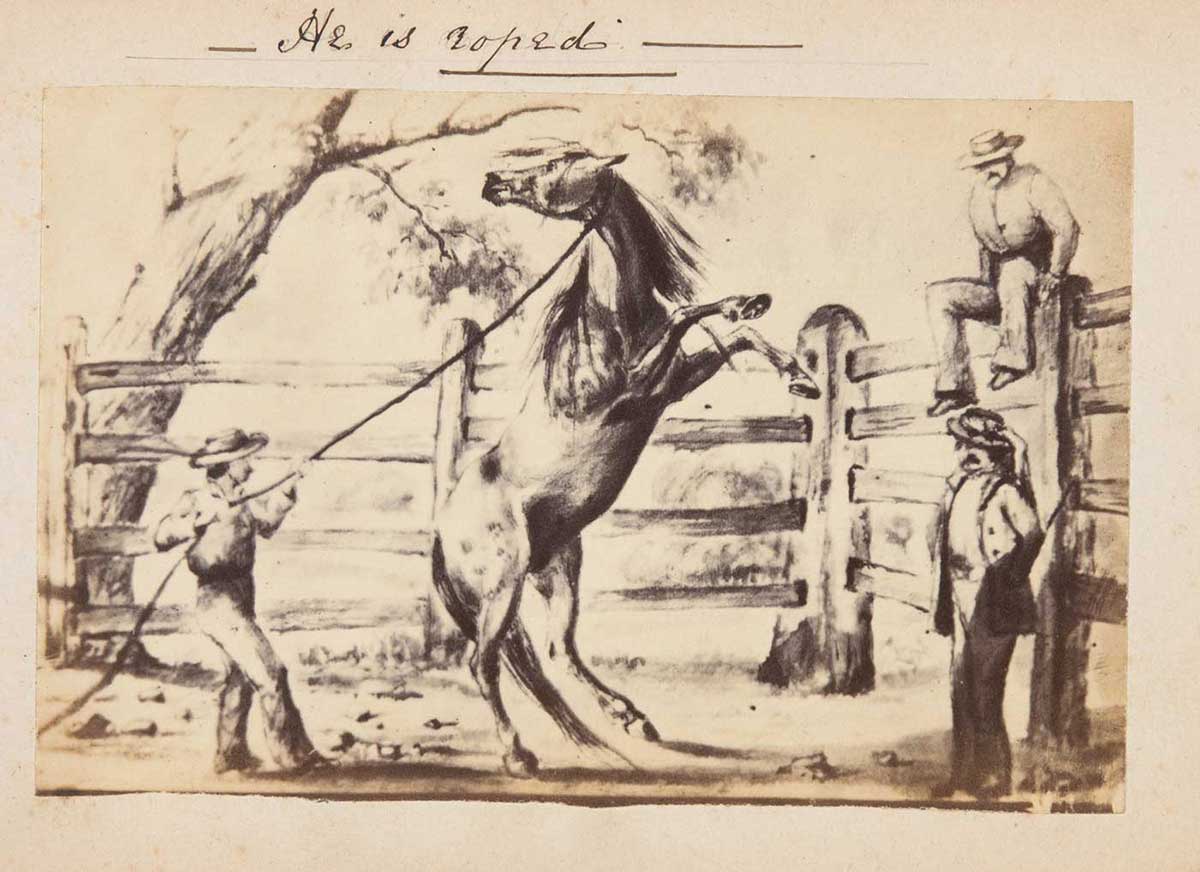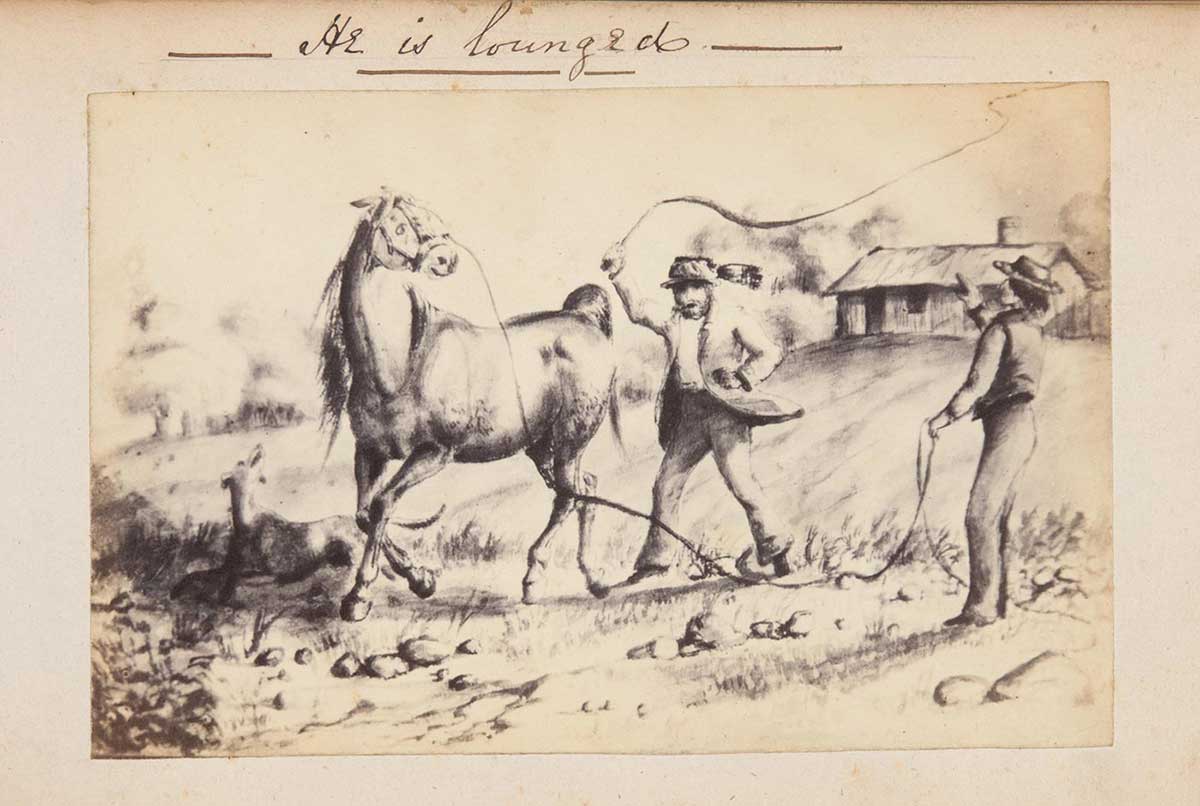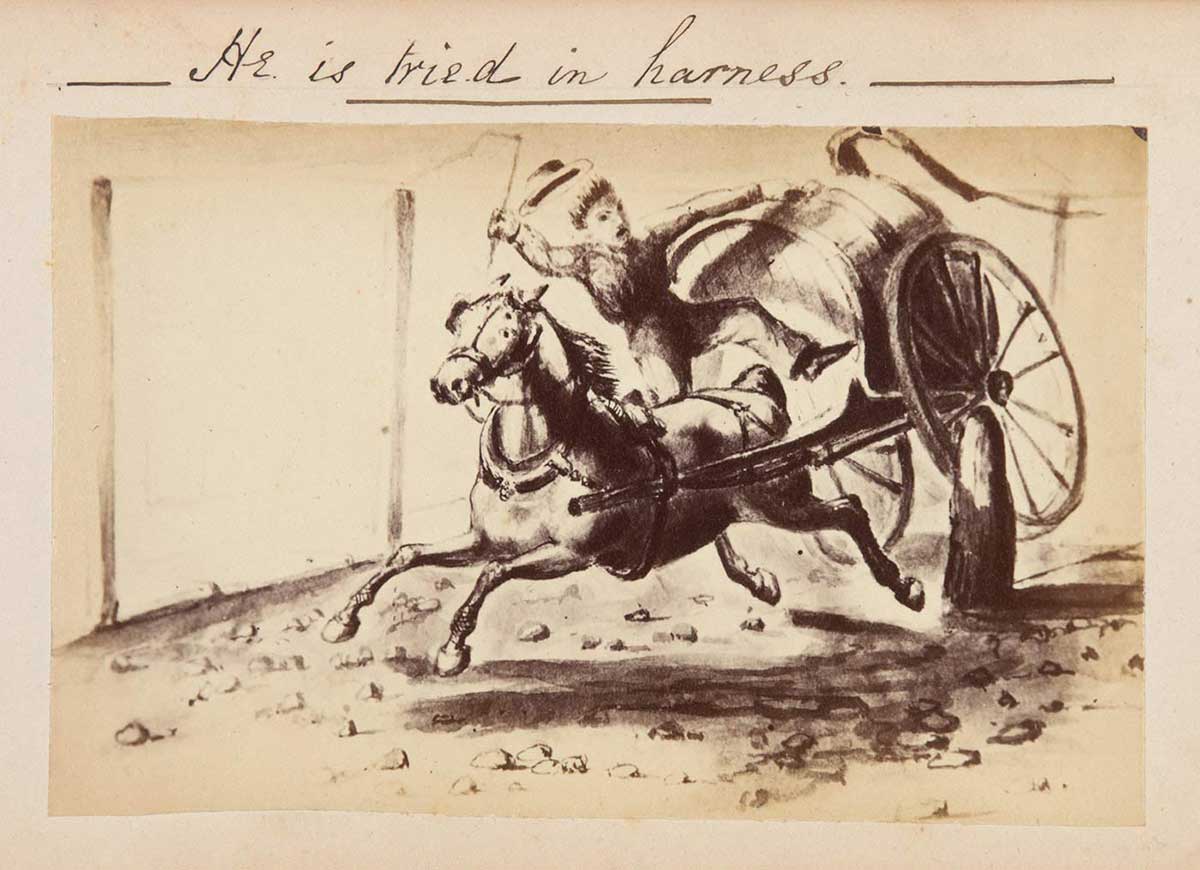Two mid-19th century publications by South Australian police commissioner George Hamilton help to reveal the early history of animal welfare in Australia.
His books, published in the 1860s, used compelling narrative and graphic images to argue for better conditions for horses, years before any formal organisation dedicated to animal care was established in Australia.
Who was George Hamilton?
George Hamilton was born in Hertfordshire, England in 1812, and went to Harrow School. He served in the navy as a midshipman before his arrival in Sydney sometime before 1837. He worked his way south overlanding sheep and cattle, settling in Adelaide in 1839.
Hamilton initially ventured into commerce and lithography, as well as forming a farming partnership with Arthur Hardy. In 1847, he helped with the organisation of South Australia’s first art exhibition, which included some of his own works.
Police career and links to explorers
In 1848 Hamilton joined the public service as a clerk within the Treasury. Four years later, he took on a position as Inspector of Mounted Police.
A succession of more senior positions followed, and he eventually became a police commissioner. He was involved in establishing the South Australian detective unit and pioneering the use of camels in the colony’s far north.
Hamilton travelled into the Northern Territory in his duties as inspector of mounted police, and was involved in the fit out of several exploring expeditions, including those of John McDouall Stuart. He contributed illustrations to the published expedition journals of George Grey and Edward Eyre.
While Hamilton was inspector he raised the standard of the mounted police to a more respected and attractive career for young men.
Artist and writer
In addition to his employment, Hamilton was active in artistic and literary circles and published short stories, essays, reminiscences and poetry, as well as his books on horses. Many were illustrated with lithographs or photographic prints of his own artworks.
Hamilton was a founding member of the South Australian Society of the Arts in 1856. An active member of the Acclimatisation Society, in 1881 he was called to advise a parliamentary committee on the impact of sparrows on farmers. Hamilton died in 1883.
Hamilton and horses
George Hamilton published his horse-related books at a time when horses were heavily relied upon for everyday activities, including both private and public transport, working the land, racing, hunting and various forms of entertainment.
Hamilton’s work with horses, through droving livestock, the mounted police and the organisation of exploration expeditions, gave him considerable expertise in the management and care of the animals.
Hamilton published three books on horse subjects, aimed at denouncing the cruel methods commonly used for breaking them in: The Horse: Its Treatment in Australia (1864), An Appeal for the Horse (1866) and A Treatise on Myles’s Side-Nail System of Shoeing Horses (1877).
An Appeal for the Horse and The Horse: Its Treatment in Australia were later released as a combined edition due to their popularity. The books were illustrated with lithographs and photographic prints from his own drawings.
Hamilton also published Experiences of a Colonist Forty Years Ago, which told the story of a droving expedition in 1879.
While written retrospectively, it suggests Hamilton’s concern for animals dated from his earliest days in Australia. In its pages, he reprimands one of his team for taking out his aggression on his horse and describes in great detail the effort they went to find water for the sheep.
He describes watching a country blacksmith make a hoof fit a shoe, rather than the other way round, and he reflects on how this must be detrimental to the horse.
Hamilton’s horse illustrations
Hamilton prepared the sketches in the photographic prints on sale for his first publication, The Horse: Its Treatment in Australia. In the preface to that publication, Hamilton thanked his friend Colonel Biggs 'for the clever and artistic way in which the gallant Colonel has converted rough sketches into exquisitely finished pictures.'
While the 26-page publication covered numerous aspects of horse mistreatment, Hamilton gave a special introduction to his images which he felt clearly illustrated his key arguments.
‘The treatment of the horse in Australia’ he wrote, 'is illustrated in eleven sketches in which are represented some—not by any means all—of the trials a horse has to go through, from the time he is taken from his native woods until he is reduced to the drudgery of a hackney car.'
It appears that the album of photographs of Hamilton’s drawings now in the Museum’s collection was made prior to the publication of The Horse: Its Treatment in Australia, for reference or use in reproduction work.
An article in The South Australian Advertiser of 11 March 1864, describes this album, reviewing the quality of his artwork separate to Hamilton’s forthcoming publication:
We had an opportunity yesterday of examining photographs of a series of eleven sketches in Indian ink by Mr. Geo. Hamilton, illustrating the treatment of the Horse in Australia. Mr. Hamilton’s skill in painting animals has been long established, and to the power of delineating the forms exactly he adds that which is the characteristic of true genius — a life like expression to each figure, so that persons looking at any sketch of his would have the feeling that they had seen the very animal he paints. This remark peculiarly applies to the set of sketches of which we are now speaking, every one of which is distinguished by perfect fidelity to nature, and they form together a true and interesting history of a horse’s career in these colonies.
The final published version of The Horse contains four mounted album photographs of Hamilton’s drawings (the other seven were not reproduced photographically), and is considered to be one of the two earliest Australian printed works to use original photographs as illustrations.
The book received generally favourable reviews, both in South Australia and in other colonies. The SA Register quoting the Argus said that ‘It is so well done and so pregnant with facts and good advice that the only fault we can find with it is that it is not longer.’
The SA Weekly Chronicle said ‘It deserves wide circulation, whether regarded as a literary and artistic circulation, or as the plea of humanity for the poor South Australian horse.’
The Horse: Its Treatment in Australia
In The Horse: Its Treatment in Australia Hamilton wrote that 'in this country the horse is liable to very few diseases, and if it were not for that prevalent epidemic the horse-breaker, the poor animal would enjoy a very comfortable existence.' Hamilton’s views on the welfare of horses were informed by his work for the mounted police, where, he observed:
It was but a short time ago that I had to examine a horse, sent to the Police Barracks for sale; on looking at the poor creatures hoofs, which bore an extraordinary appearance, I found the frog reduced (by the practice of cutting away the sides) to a thin groove in the hoof, so cracked and withered, that not a particle of its delicate texture remained; its heart shape had entirely disappeared, and as a certain consequence the heel had contracted so much as to interfere considerably with the action of the crippled animal. What the poor brute had suffered, or was then suffering, from the effects of the ignorance of his shoer, no one can tell; but those who know something of the delicate structure of the hoof, can imagine the dreadful pain the poor uncomplaining creature had to endure.
He describes the average horse breaker as ‘unfitted by temper, education or habits, to have the control over any animal whose skin is thinner than that of a hippotamus, or whose temper is milder than that of a wild boar’. ‘In the name of humanity’, he wrote, ‘let us prevent that class of swaggering, dirty, disreputable looking men, whose habitat is a public house, and whose occupation is drinking and smoking, from torturing our horses.
An Appeal for the Horse
In An Appeal for the Horse, Hamilton describes the plight of the horse in South Australia and the English notion of horse ‘breaking’ which was carried on in Australia.
The book begins by explaining to horse owners and grooms the impossible living conditions most horses have in the stables and why the ill-conceived and often cruel methods of training these horses will leave them timid and lame.
Hamilton illustrates to these breeders why horses that do not respond to the ‘conventional’ techniques of training will begin to get better when kept in a more natural environment, outside, where the dark, cold, tiny stables full of cobwebs and dust can’t break the horses spirit and impede their breathing.
Hamilton goes on to compare the treatment of horses in other cultures, what has worked and what has not, and appeals to horse owners, breeders and grooms to treat their horses with kindness. The best example Hamilton describes is that of the ‘Arabs of the desert’, whose fair but firm kindness in dealing with the horse is repaid with respect and years of steady work and companionship.
He addresses the book to South Australia, but urges the rest of Australia to abandon the ways of Britain and as a ‘new young’ colony embrace a more humane approach: ‘I can state most positively that in very few instances has kindness failed to improve the horse, and in no instance has harshness succeeded in doing so’.
References
George Hamilton, Australian Dictionary of Biography
The Horse: Its Treatment in Australia, Victoria University of Wellington Library
Jordan Curnutt, Animals and the Law: A Source Book, ABC-Clio, Santa Barbara, 2001.
George Hamilton, Experiences of a Colonist Forty Years Ago: A Journey from Port Phillip to South Australia in 1839; and A Voyage from Port Phillip to Adelaide in 1846 by an Old Hand, Libraries Board of South Australia, Adelaide, 1974.
B Harrison, 'Animals and the state in nineteenth-century England', in The English Historical Review, vol. 88, no. 349, Oct 1973, pp. 786–820.
K Symes, ‘Notes on the History of Royal Society for the Prevention of Cruelty to Animals (South Australia) Incorporated', 1875–1975.











